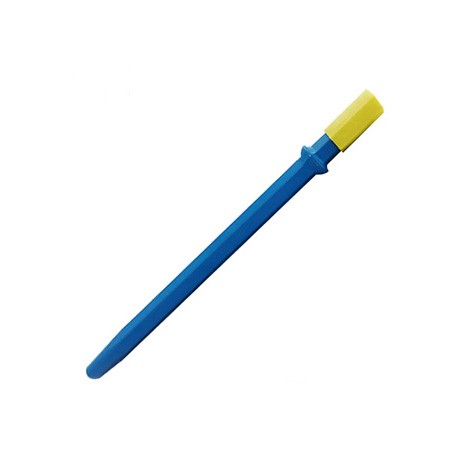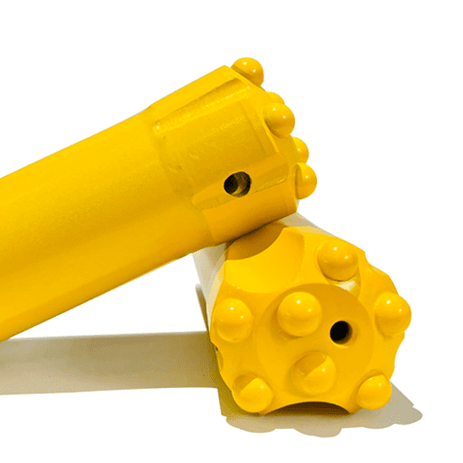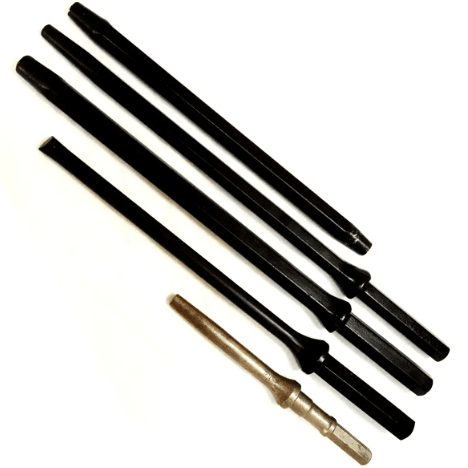Taper drill rods are essential tools in the world of rock drilling, offering a robust and efficient solution for creating holes in various rock formations. This guide dives deep into the world of taper drill technology, explaining their function, types, and why they are the go-to choice for many hole drilling operations. If you're involved in quarry work, construction, or mining, understanding taper drill rods can significantly boost your drilling efficiency and productivity.
1. What is a Taper Drill Rod and How Does it Differ from Other Drill Rods?
A taper drill rod, often simply called a taper rod, is a specialized type of drill rod designed with a taper at one end. This taper is a conical section that precisely matches the taper in a taper drill drill bit. This creates a secure and efficient connection that transmits the percussive energy from the rock drill to the drill bit. Unlike straight drill rods that rely on threads or other mechanical connections, the taper joint allows for quick attachment and detachment, crucial in fast-paced drilling operations. The taper ensures a tight fit, maximizing energy transfer and minimizing vibration, leading to more effective hole drilling. The distinctive taper is what sets this rod apart.
The primary difference lies in the connection mechanism. While other drill rods might use threads or couplings, taper drill rods utilize the friction fit created by the precisely matched taper angles. This design simplifies the connection process. You simply align the taper of the drill bit with the taper of the drill rod and apply force, usually from the rock drill, to create a secure joint. This eliminates the need for wrenches or specialized tools for connection, making it faster and more convenient, particularly in demanding environments like a quarry. This efficient energy transfer from the rock drill to the drill is a key advantage.
2. What Makes Taper Drill Rods Ideal for Small Hole Drilling?
Taper drill rods are particularly well-suited for small hole drilling applications. The taper connection provides excellent alignment and stability, which is critical when drilling smaller diameter holes where precision is paramount. The design of the taper allows for efficient transmission of pneumatic or hydraulic power from the rock drill to the drill bit, even with smaller diameter rods. This ensures effective cutting action for creating clean and accurate small holes.
Furthermore, the ease of connecting and disconnecting taper drill rods is a significant benefit in small hole drilling, especially in applications requiring frequent bit changes. Whether you are working in a granite and marble quarry or on a construction site, the speed and simplicity of the taper system save valuable time and effort. The robust connection minimizes energy loss, maximizing the impact on the rock formations, making even powerful hydraulic rock drills effective for small hole drilling. This makes taper drill systems a preferred choice for shallow hole drilling operations and various construction projects.
3. Exploring Different Taper Angles: What are the Common Specifications?
The taper angle is a critical specification of a taper drill rod, directly influencing the security and efficiency of the connection with the drill bit. Common taper angles include 7 degrees, 11 degrees, and 12 degrees. The choice of taper angle often depends on the type of rock formations being drilled and the power of the rock drill. Steeper taper angles, like 12 degrees, generally provide a tighter fit and are suitable for drilling medium-hard to hard rock.
Shallower taper angles, such as 7 degrees, offer easier connection and disconnection, which can be advantageous in certain situations. However, they might not provide the same level of holding power in very hard rock. The industry often refers to these by their degree, such as a "7-degree taper rod" or a "12-degree taper rod". Understanding these taper angles is crucial for ensuring compatibility between the drill rod and the drill bit. Selecting the correct angle ensures optimal energy transfer from the rock drill and prevents premature wear or slippage. From a chinese supplier’s perspective, offering a range of professional tapered options is key to meeting diverse customer needs.

4. What are the Key Components of a Taper Drill Rod System?
A typical taper drill rod system consists of several key components working in harmony. The taper drill rod itself is the central element, with a precise taper at the bit end designed to connect with the drill bit. The other end of the rod usually features a shank, which is the part that connects to the rock drill. Different shank designs exist to match various drill models.
The drill bit, often a button bit or chisel bits, is another crucial component. The drill bit has a matching taper socket that fits snugly onto the taper of the drill rod. Impact energy from the rock drill travels through the shank, down the drill rod, and into the drill bit to fracture the rock. Sometimes, a shank adapter might be used to connect the drill rod to a rock drill with a different shank configuration. Understanding how these components interact is vital for optimizing drilling operations.
5. Selecting the Right Taper Drill Rod: Matching the Drill Bit and Rock Drill
Choosing the correct taper drill rod involves careful consideration of several factors. First and foremost, the taper angle of the drill rod must precisely match the taper angle of the drill bit. Using mismatched tapers can lead to a weak connection and potential damage. Secondly, the shank type of the drill rod must be compatible with the chuck of your rock drill. Manufacturers provide specification charts to help you identify the correct matches.
The length and diameter of the drill rod are also important considerations, depending on the depth of the holes you need to drill. The type of rock drill you are using (e.g., pneumatic rock drills or hydraulic rock drills) will also influence your selection. Heavier, more powerful drill rigs might require more robust drill rods. Consulting with manufacturers and suppliers is always recommended to ensure you select the optimal taper drill rod for your specific rock drilling operations.

6. What are the Advantages of Using Taper Drill Rods in Granite and Marble Quarries?
Granite and marble quarry operations benefit significantly from the use of taper drill rods. The precise and efficient hole drilling capabilities of taper systems are crucial for extracting these valuable materials. The quick connect/disconnect feature of taper drill rods minimizes downtime during bit changes, increasing overall productivity in the quarry. This is especially important when dealing with the hard and abrasive rock formations often found in these environments.
The robust connection provided by the taper ensures efficient energy transfer, maximizing the effectiveness of each impact from the rock drill. This leads to faster penetration rates and reduced wear on the drilling tool. Furthermore, the relative simplicity of the taper system makes maintenance easier, a valuable asset in the demanding environment of a quarry. For operations focused on extracting dimension stone, the accuracy and clean holes produced by taper drill systems are paramount.
7. How to Properly Maintain Your Taper Drill Rods for Longevity?
Proper maintenance is essential for maximizing the lifespan and performance of your taper drill rods. Regular inspection for wear and tear, especially on the taper and shank, is crucial. Ensure the taper surfaces are clean and free from debris before each connection to guarantee a secure fit. Lubricating the taper joint can also help prevent seizing and facilitate easier separation.
Store drill rods in a dry and organized manner to prevent damage and corrosion. When sharpening drill bits, ensure the taper socket remains clean and undamaged. Avoid excessive force when connecting or disconnecting taper drill rods, as this can lead to deformation of the taper. Following these simple maintenance steps will not only extend the life of your drill rods but also ensure safe and efficient drilling operations.
8. Beyond Standard Steel: Are There Other Materials Used in Taper Drill Rods?
While tapered steel is the most usually used material for taper drill rods due to its strength and durability, other materials are sometimes employed for specific applications. High-quality alloy steels can offer enhanced resistance to wear and fatigue, particularly beneficial in aggressive rock formations. Surface treatments, such as carburization or nitriding, can further improve the wear resistance and lifespan of steel drill rods.
In some specialized applications, particularly where weight is a concern, lighter materials might be explored, although this is less common for standard taper drill rods. The core requirement remains high strength and resistance to the repeated impact and abrasion encountered during rock drilling. Therefore, advancements in steel metallurgy continue to be the primary focus for improving taper drill rod performance.
9. Taper Drill Rods vs. Integral Drill Rods: Which is Right for Your Drilling Needs?
Choosing between taper drill rods and integral drill rods depends on the specific drilling operations and equipment being used. Integral drill rods, also known as one-piece drill rods, have the drill bit permanently attached to the drill steel. This eliminates the connection point, offering a simpler system and preventing issues related to taper fit. Integral drill rods are often preferred for low impact rock drills and softer rock drills and softer rock conditions.
Taper drill rods, on the other hand, offer greater flexibility. The detachable drill bit allows for easy replacement when worn, reducing overall cost. They are generally favored for impact rock drills and softer and harder rock drills and softer rock formations, especially where different drill bit types might be needed. For small hole drilling, both options are viable, but taper drill rods offer more adaptability. The choice often comes down to balancing simplicity with flexibility and cost-effectiveness.

10. Finding a Reliable Taper Drill Rod Supplier: What to Look For?
When sourcing taper drill rods, selecting a reliable supplier is crucial for ensuring quality and performance. Look for a supplier with a proven track record and experience in manufacturing rock drilling tools. Check for certifications and adherence to quality standards. A reputable supplier should offer a comprehensive specification range to meet various drilling needs.
Consider the supplier's ability to provide technical support and guidance in selecting the right drill rods for your specific application. Competitive pricing is important, but prioritize quality and reliability to avoid costly downtime. A good supplier will also have efficient logistics and shipping processes. As a leading supplier in the industry, we understand these needs and strive to provide high-quality taper drill rods at a competitive price.
Key Takeaways:
- Taper drill rods are essential for efficient small hole drilling, offering a secure and quick connection.
- The taper angle is a critical specification, with common angles being 7, 11, and 12 degrees.
- A taper drill rod system includes the drill rod, drill bit, and often a shank.
- Matching the drill bit and rock drill to the taper drill rod is crucial for optimal performance.
- Taper drill rods are advantageous in granite and marble quarries due to their efficiency and precision.
- Proper maintenance is vital for extending the lifespan of taper drill rods.
- While steel is common, other materials and treatments exist for specialized applications.
- The choice between taper drill rods and integral drill rods depends on the specific drilling needs.
- Selecting a reliable supplier is crucial for quality and support.
For all your rock drilling equipment needs, including high-quality taper drill rods, explore our range of tapered drill pipes. We offer durable and efficient solutions for various drilling applications. You can also find compatible rock drilling bits and hammer hand drill options to complete your setup.
Post time: 1 月-02-2025














